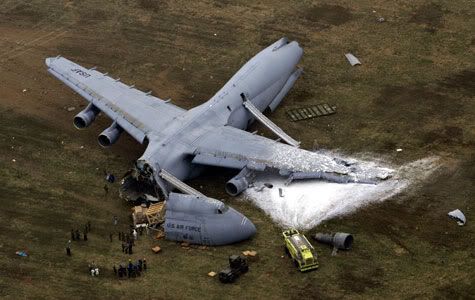
Cargo plane breaks apart in US
2006-04-04
Emergency crews respond to the scene of a C-5 cargo plane that crashed carrying 17 people, just short of a runway at Dover Air Force Base yesterday. -- AP
A HUGE military cargo plane faltered after takeoff and belly-landed short of the Dover Air Force Base runway, breaking apart and drenching some of the 17 people aboard with fuel but causing no fire or life-threatening injuries, the Associated Press said.
"It is a miracle. Absolutely a miracle," said Lt Col Mark Ruse, commander of the base's 436th Air Wing Civil Engineering squadron yesterday. "If you look at the condition of that plane and 17 people are still alive right now -- it is absolutely amazing."
A problem occurred aboard the C-5B Galaxy, the military's largest plane, about 10 minutes after it took off for Spain. The crew turned the plane around for the crash landing, which occurred at 6:42am, said Col Chad T. Manske, 436th Airlift Wing vice commander.
Manske did not provide specifics on what went wrong, but Delaware Senator Tom Carper, who was briefed by military officials, said he was told the crew reported a malfunction in one of the plane's four engines.
The plane crashed in an open, grassy area about a half-mile (kilometer) short of the runway. The tail and nose were torn from the fuselage, along with one of the engines. Some of the 250,000 pounds (112,500 kilograms) of fuel spilled on the ground but did not ignite.
"It looks like it kind of slid along the ground almost like a water landing of sorts," Ruse said.
Pilots familiar with the plane say its sheer size -- roughly that of a football field -- likely contributed to the fact that there were no deaths.
"It's like being in a four-story building," said retired Col Randall Larsen, a former C-5 pilot who described the plane as one of the safest in Air Force history. The C-5B is the newest version of the C-5, which was introduced in 1970.
The fact that the fuel is stored in the wings, which unlike many other planes are mounted atop the fuselage, may explain the absence of fire, said Larsen, director of the Institute for Homeland Security, a think tank Virginia.
Larsen also said that if the crew was able maintain some control of the aircraft, it was not surprising that they survived.
Some of the crew members were able to walk away and none suffered life-threatening injuries, hospital and military officials said.
Fourteen were taken to Kent General Hospital in Dover, and three were admitted. Some were covered with flammable jet fuel and had to be decontaminated in the hospital parking lot before they could be taken inside.
Three others were taken by helicopter to a hospital in Newark, New Jersey.
Military officials said everyone was in "fair, or better" condition.
"With that much jet fuel on the plane, not to explode, not to have consumed everyone's life, is just miraculous," Carper, a formal naval flight officer, said. "The fact that they landed the plane in a farm field ... instead of a neighborhood or a populated part of Dover is obviously a great thing."
Air Force officials said the plane was carrying supplies to support US troops in the Middle East, its final destination.
Base spokeswoman Lt Chris Sukach said there two active-duty personnel on the plane and 11 reservists, 10 from Dover and one from Wright-Patterson Air Force Base in Ohio. Sukach said four civilians also were aboard.
Shanghai Daily News








